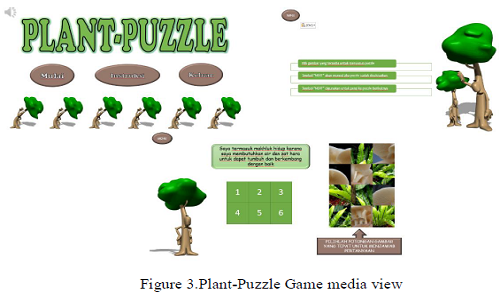
Development of Plant-Puzzle Games (PPG) based on the Learning Styles of Junior High School Students to Increase Learning Motivation in Plant Classification Materials
Abstract
Keywords
Full Text:
PDFReferences
Dalgarno, B., Kennedy, G., and Bennett, S. (2014). The impact of students’ exploration strategies on discovery learning using computer-based simulation. Educational Media International, 51(4), 310-329.
De Porter, B. dan Hernacki, M. (1992). Quantum learning: Unleashing the genius in you. New York: Dell Publishing.
Din, Z.U., dan Gibson, G.E. (2019). Serious games for learning prevention through design concepts: An experimental study. Safety Science, 115, 176-187.
Dina, N.Z., Sabilla, W.I., dan Kartono. (2019). The impact of using visual learning environment on student programming course learning achievement: A case study of Universitas Airlangga. Journal of Engineering Science and Technology, 14(2), 712 - 725.
Gardner, F.P., Pearce, R.B., dan Mitchell, R.L. (1991). Physiology of crop plants. Jakarta: UI Press.
Gee, J.P. (2003). What video games have to teach us about learning and literacy. Computers in Entertainment, 1(1), 20-20.
Hake, Richard R. (1998). Interactive-Engagement Versus Traditional Methods: A Six Thousand-Student Survey of Mechanics Test Data for Introductory Physics Courses. American Journal of Physics, 66(1), 64-74.
Ichsan, I. Z., dkk., (2019). Higher order thinking skills assessment based on environmental problem (HOTS-AEP): MEndesain evaluasi pembelajaran abad 21. Jurnal Biotek, 7 (1), 14-26.
Jacquemart, A.L., dkk., (2016). An interactive multimedia dichotomous key for teaching plant identification. Journal of Biological Education, 50(4), 442-451.
Khan, F.M.A. dan Masood, M. (2013). The development and testing of multimedia-assisted mastery learning courseware with regard to the learning of cellular respiration. Procedia Social and Behavioral Sciences, 103, 999-1005.
Kustandi, C., dan Sutjipto, B. (2016). Media Pembelajaran Manual dan Digital. Bogor: Ghalia Indonesia.
Lamb, R.L., dkk. (2018). A meta-analysis with examination of moderators of student cognition, affect, and learning outcomes while using serious educational games, serious games, and simulations. Computers in Human Behavior, 80, 158-167.
Lin, C.H. dan Chen, C.M. (2016). Developing spatial visualization and mental rotation with a digital puzzle game at primary school level. Computers in Human Behavior, 57, 23-30.
Martin W., Slinder, M., dan Rutter, S. (2018). Digital games as sources for science analogies: Learning about energy through play. Computers & Education, 130, 1-12.
Meltzer, David E. (2002) The Relationship between Mathematics Preparation and Conceptual Learning Gains in Physics: A Possible “hidden variable” in Diagnostic Pretest score. American Association of Physics Teachers. 1259-1268.
Park, B., dkk. (2016). The role of spatial ability when fostering mental animation in multimedia learning: An ATIstudy. Computers in Human Behavior, 64, 497-506.
Philiyanti, F., dkk. (2019). Android-based learning media in contextual teaching and learning on Japanese language reading. Journal of Engineering Science and Technology, 14(3), 1138 - 1149.
Purba, A. S., dkk. (2020). Development of Games Instruction Within Plant Growth Concept. Journal og Engineering Science and Technology, Special Issue on AASEC2019, 1-10.
Ramalingam, A., Morales, A.J., dan Walker, J.M. (2018). Varying experimental instructions to improve comprehension: Punishment in public goods games. Journal of Behavioral and Experimental Economics, 73, 66-73.
Richey, R. C. dan Klein, J. D. (2014). Design and development research. In handbook of research on educational communications and technology (pp. 141-150). New York: Springer.
Rolando, L.G.R., dkk. (2014). Learning with their peers: Using a virtual learning community to improve an in-service biology teacher education program in Brazil. Teaching and Teacher Education, 44, 44-55.
Rowe, E., dkk. (2014). Crossing the bridge: Connecting game-based implicit science learning to the classroom. Proceedings of the 10th annual games, learning, society conference University of Wisconsin, Madison, US, 1-7.
Santrock, J. W. (2004). Educational psychology (4th ed). New York: McGraw Hill Education.
Smaldino, S.E., dkk. (2008). Instructional technology and media for learning. United States of America: Pearson Education.
Susanto, H. dan Akmal, H. (2019). Media Pembelajaran Sejarah Era Teknologi Informasi. Banjarmasin: Universitas Lambung Mangkurat.
Végh, V., dkk. (2017). The effects of using Edmodo in biology education on students' attitudes towards biology and ICT. Problems of Education in the 21st Century, 75(5). 483-495.
Yaumi, M. (2018). Media dan Teknologi Pembelajaran. Jakarta:Prenamedia Group.
Young, M.F. dan Slota, S.T. (2017). Castle upon a hill. In M. F. Young, & S.T. Slota (Eds.). Exploding the castle: Rethinking how video games and game mechanics can shape the future of education (pp. 3-18). United States of America: IAP, Inc.
DOI: http://dx.doi.org/10.31258/jes.6.2.p.225-235
Refbacks
- There are currently no refbacks.
Copyright (c) 2022 Fitri Rizkiyah

This work is licensed under a Creative Commons Attribution 4.0 International License.
Publisher: FKIP Universitas Riau












